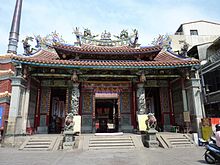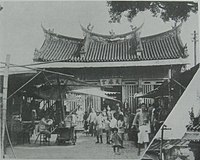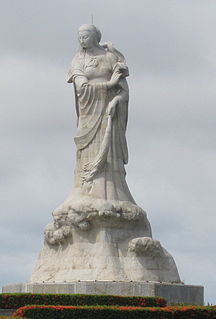
Mazu or Matsu is a Chinese sea goddess also known by several other names and titles. She is the deified form of the legendary figure Lin Mo or Lin Moniang, a Fujianese shamaness whose life span is traditionally dated from 960 to 987. Revered after her death as a tutelary deity of seafarers, including fishermen and sailors, her worship spread throughout China's coastal regions and overseas Chinese communities throughout Southeast Asia and even to the United States, where some Mazuist temples are affiliated with famous Taiwanese temples. She was thought to roam the seas, protecting her believers through miraculous interventions. She is now generally regarded by her believers as a powerful and benevolent Queen of Heaven. Mazu worship is popular in Taiwan as large numbers of early immigrants to Taiwan were Hoklo people; her temple festival is a major event in the country, with the largest celebrations around her temples at Dajia and Beigang.

The Kangxi Emperor, born Xuanye, was the third emperor of the Qing dynasty, and the second Qing emperor to rule over China proper, reigning from 1661 to 1722.

Zheng Jing, Prince of Yanping, courtesy names Xianzhi (賢之) and Yuanzhi (元之), pseudonym Shitian (式天), was a 17th-century Chinese warlord, Ming dynasty loyalist and ruler of the Kingdom of Tungning in Taiwan.

Zhu Shugui, courtesy name Tianqiu (天球) and art name Yiyuanzi (一元子), the Prince of Changyang, later the Prince of Ningjing (寧靖王), was a royal member of the Ming and the last of the pretenders to the throne of Southern Ming after the execution of the Yongli Emperor in 1662. He took shelter to the Kingdom of Tungning in Taiwan after mainland China completely fell under the control of Manchu-led Qing dynasty. Despite his status as a royal member, he virtually shared no political power with the Zheng dynasts whom were the actual rulers of the kingdom. After the Qing forces successfully annexed Taiwan in 1683, he committed suicide. Nowadays there is a temple dedicated to the prince in Lujhu Township. Inside the temple is written Zhu's death poem.
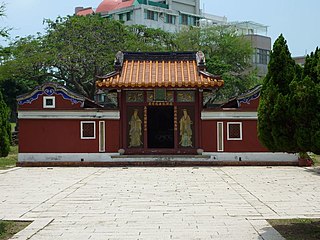
The Temple of the Five Concubines, known also by alternative names including the Temple of the Five Noble Ladies, is a temple in West Central District, Tainan, Taiwan. It was built in front of the tomb of the five concubines of Zhu Shugui, the Ming Prince of Ningjing, who killed themselves in 1683 to accompany him in death. It is registered as a first-class historic site by the Republic of China government.
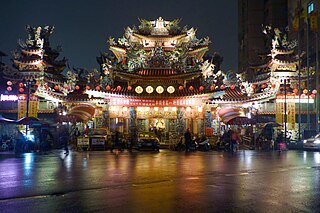
Ciyou Temple is a prominent Chinese temple in Songshan District, Taipei, Taiwan. The temple is dedicated to the Goddess Matsu. Raohe Street Night Market was located next to this temple as the temple has been a prominent landmark in the area.
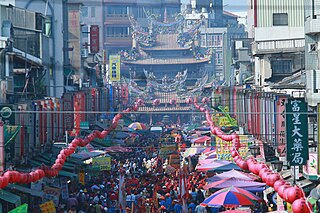
The Chaotian or Chaotien Temple, officially the Chao-Tian Temple, is a temple to the Chinese Goddess Mazu in Beigang Township, Yunlin County, Taiwan. Constructed in 1700, it became one of the most important Mazu temples in Taiwan and is known for its extravagant temple architecture. It is visited by more than a million pilgrims every year.
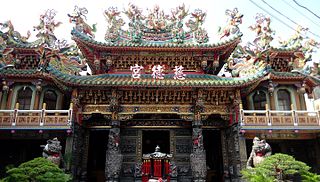
The Cide Temple on Dianziding Street, also known as the Dianziding, Liujia, Mazu, or Tianhou Temple, is a temple northwest of Lotus Lake in Zuoying District, Kaohsiung, Taiwan. In Chinese, it is commonly distinguished by its location.

The Dajia Jenn Lann Temple, also known as the Zhenlan or Mazu Temple, is a temple dedicated to the Chinese Goddess Mazu, the Goddess of Sea and Patron Deity of fishermen, sailors and any occupations related to sea/ocean. The temple is located in the Dajia District of Taichung, Taiwan. It is known for being the start of the Dajia Mazu Pilgrimage, an annual celebration of the sea goddess.

Shunfeng'er is a Chinese sea and door god. He usually appears with Qianliyan as a guardian of the temples of the sea goddess Mazu.

The Tianhou or Mazu Temple is a temple to the Goddess Mazu, the Chinese Goddess of Sea and Patron Deity of fishermen, sailors and any occupations related to sea/ocean. It is located in Xinwu District, Taoyuan City, Taiwan.

The Tianhou Temple, also known as the Kaitai Tianhou or Mazu Temple, is a temple to the Chinese Goddess Mazu, who is the Goddess of Sea and Patron Deity of fishermen, sailors and any occupations related to sea/ocean. The temple is located in the Anping District of Tainan on Taiwan.

The Lukang Tianhou Temple, also known as the Lukang Mazu Temple, is a Chinese temple dedicated to the Chinese Goddess Mazu, the Goddess of Sea and Patron Deity of fishermen, sailors and any occupations related to sea/ocean. The temple is located at 430 Zhongshan Road in Lukang Township, Changhua County, Taiwan. It is one of the island's most famous and popular Mazu temples.

The Penghu Tianhou Temple is a temple dedicated to the sea goddess Mazu located on Zhengyi Street in Magong City, Penghu, Taiwan. It is usually considered the oldest Mazu temple in Taiwan and, despite differences in characters, is the namesake of the surrounding city of Magong. It is open from 7:00 am to 5:30 pm daily.

The Zhonggang Cihyu Temple is a Chinese temple dedicated to the Goddess Mazu, who is the Goddess of Sea and Patron Deity of fishermen, sailors and any occupations related to sea/ocean. It is located in Zhunan Township, Miaoli County, Taiwan and is also the oldest Matsu temple in Miaoli county.
The architecture of Taiwan can be traced back to stilt housing of the aborigines in prehistoric times; to the building of fortresses and churches in the north and south used to colonize and convert the inhabitants during the Dutch and Spanish period; the Tungning period when Taiwan was a base of anti-Qing sentiment and Minnan-style architecture was introduced; in Qing dynasty period, a mix of Chinese and Western architecture appeared and artillery battery flourished during Qing's Self-Strengthening Movement; During the Japanese rule of Taiwan, the Minnan, Japanese and Western culture were main influencers in architectural designs and saw the introduction and use of reinforced concrete. Due to excessive Westernization as a colony, after the retrocession of Taiwan to the Republic of China in 1945 from Japan at the end of World War II, Chinese classical style became popular and entered into international mainstream as a postmodern design style. Today, Taiwanese architecture has undergone much diversification, every style of architecture can be seen.
Events from the year 1683 in China.

The Jinbanjing Tianhou Temple is a Mazu temple in Ren'ai Village, Nangan Township, Lienchiang County, Taiwan.
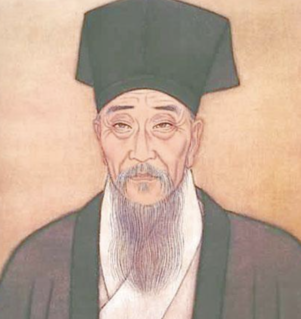
Liu Guoxuan (1628-1693) was the Wuping Marquis and a 17th-century military officer of the Kingdom of Tungning based in Taiwan. He fought all over the island of Taiwan and the nearby mainland. He also commanded the Penghu defense during the Battle of Penghu.
